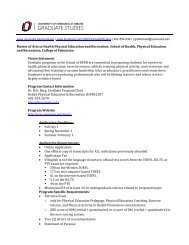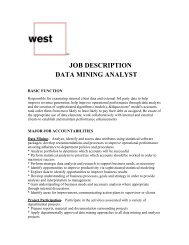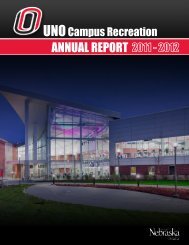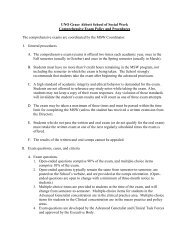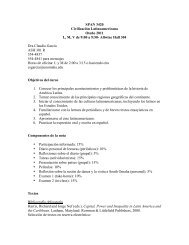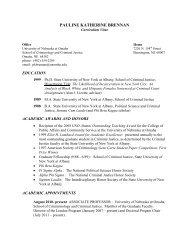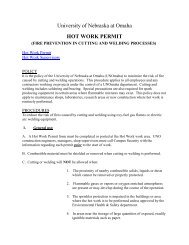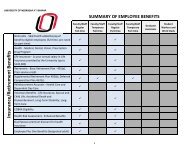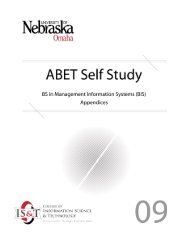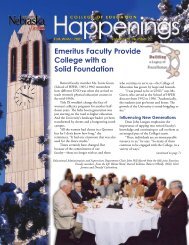WRITING IN THE MAJORS: - University of Nebraska Omaha
WRITING IN THE MAJORS: - University of Nebraska Omaha
WRITING IN THE MAJORS: - University of Nebraska Omaha
You also want an ePaper? Increase the reach of your titles
YUMPU automatically turns print PDFs into web optimized ePapers that Google loves.
Campus Writing Day Presentation, Center for Instructional Design<br />
Nov. 13, 2008 John C. Bean<br />
<strong>WRIT<strong>IN</strong>G</strong> <strong>IN</strong> <strong>THE</strong> <strong>MAJORS</strong>:<br />
Designing the Curriculum Backwards to Accelerate Students’<br />
Growth as Disciplinary Thinkers and Writers<br />
<strong>University</strong> <strong>of</strong> <strong>Nebraska</strong>-<strong>Omaha</strong><br />
Monday, February 2, 2009, 2:30-4:00<br />
Presenter: John C. Bean, Seattle <strong>University</strong><br />
It seems to me, then, that the way to help people become better writers is not to tell them that they must first<br />
learn the rules <strong>of</strong> grammar, that they must develop a four-part outline, that they must consult the experts<br />
and collect all the useful information. These things may have their place. But none <strong>of</strong> them is as crucial as<br />
having a good, interesting question.<br />
[Rodney Kilcup, Historian, from a 1980s Puget Sound Writing Project Newsletter]<br />
Introduction to WAC Pedagogy<br />
An introduction to WAC pedagogy: Scenarios for discussion 2<br />
Some general principles for teaching academic writing in the disciplines 3<br />
Issues in Assignment Design<br />
Formal assignment handout for a first-year history seminar assignment (with discussion questions) 4<br />
Rubric for the history assignment 5<br />
Four effective ways to create problem-based assignments 6<br />
Writing in the Majors: A Theory <strong>of</strong> Student Writing Development<br />
Development <strong>of</strong> students’ writing skills: Novice to expert 8<br />
Skills/knowledge needed to become a disciplinary insider 9<br />
Introducing New Majors to Disciplinary Research<br />
Teaching research rhetorically: Explaining how your discipline uses evidence<br />
and joins conversations 10<br />
A skill-building research assignment for English majors (with rubric) 11<br />
Example <strong>of</strong> a backward designed assignment sequence 13<br />
Appendix: More Assignment Examples<br />
Extending WAC pedagogy across the curriculum: Examples <strong>of</strong> problem-based tasks 14<br />
Powerful Homework: . . . I find it fascinating that in faculty discussions about curriculum and course structure . .<br />
. 90 percent <strong>of</strong> our discussion focuses on what material and ideas to cover in class. We pay far less attention to the<br />
details <strong>of</strong> homework assignments. So it is good for faculty to learn from students that the design <strong>of</strong> homework, and<br />
how we ask students to do that homework, matters a lot . . . (51).<br />
Writing and Student Engagement: . . . The results are stunning. The relationship between the amount <strong>of</strong> writing for<br />
a course and students’ level <strong>of</strong> engagement—whether engagement is measured by time spent on the course, or the<br />
intellectual challenge it presents, or students’ level <strong>of</strong> interest in it—is stronger than the relationship between<br />
students’ engagement and any other course characteristic. . . . (55)<br />
--from Richard J. Light. (2001). Making the Most <strong>of</strong> College: Students Speak Their Minds. Harvard U. Press
Writing in the Majors <strong>University</strong> <strong>of</strong> <strong>Nebraska</strong>-<strong>Omaha</strong>, February 2, 2009 John C. Bean 2<br />
AN <strong>IN</strong>TRODUCTION TO WAC PEDAGOGY:<br />
SCENARIOS FOR DISCUSSION<br />
Imagining Students’ Studying and Thinking Processes<br />
Scenario 1 [First-Year Gen Ed Course]<br />
Imagine that you are teaching an “Introduction to Psychology” course, primarily to first year students<br />
early in their college careers. It is Monday. For Wednesday’s class you want them to read the textbook<br />
chapter explaining some <strong>of</strong> the important modern schools <strong>of</strong> psychology. How might students’ studying<br />
and thinking processes differ depending on the way you give the homework task?<br />
1. For Wednesday, read Chapter 2.<br />
2. For Wednesday, read Chapter 2 and be prepared for a quiz.<br />
3. For Wednesday, read Chapter 2 and then write a half-page, single spaced “thinking piece”<br />
that addresses the following question: Suppose you are a parent who goes to a child<br />
psychologist for advice on how to get your 10 year old child to practice the piano. It seems<br />
the child rushes out <strong>of</strong> the room screaming every time you insist he practices. What different<br />
advice would you get if the child psychologist were a behaviorist, a psychoanalyst, or a<br />
humanistic psychologist? Explain your reasoning. Come to class with your completed<br />
thinking piece and be prepared to share your ideas with classmates.<br />
Scenario 2 [Gateway course for novice English majors]<br />
Imagine that you are teaching a 19 th Century British novel course, primarily to students who are just<br />
starting their literature studies. For next Monday’s class you want them to finish Mary Shelley’s<br />
Frankenstein. How might students’ studying and thinking processes differ depending on the way you give<br />
the homework task?<br />
1. For next week, finish Frankenstein. There will be a quiz.<br />
2. For next week, finish Frankenstein and then write a one-page, single spaced “thinking piece”<br />
that addresses the following question: Critic Harold Bloom has said, “The greatest paradox<br />
and most astonishing achievement <strong>of</strong> Mary Shelley’s novel is that the monster is more human<br />
than his creator.” To what extent do you agree with Bloom’s assertion? Play the believing<br />
and doubting game with Bloom’s thesis. Spend half a page making the case that the monster<br />
is more human than Victor Frankenstein. Then spend a half page arguing against Bloom’s<br />
view. Which view is closest to yours? Come to class with your completed thinking piece and<br />
be prepared to share your ideas with classmates.<br />
Discussion question: If you decided to try out Strategy 3 for either scenario, don’t worry for now what you<br />
would do with all those thinking pieces. We’ll deal with that question later. For now, just focus on how<br />
each <strong>of</strong> these strategies might alter the way students studied. Please explore with colleagues at your table<br />
how students would read and study differently depending on how the homework task was assigned.
Writing in the Majors <strong>University</strong> <strong>of</strong> <strong>Nebraska</strong>-<strong>Omaha</strong>, February 2, 2009 John C. Bean 3<br />
SOME GENERAL PR<strong>IN</strong>CIPLES FOR TEACH<strong>IN</strong>G ACADEMIC<br />
<strong>WRIT<strong>IN</strong>G</strong> <strong>IN</strong> <strong>THE</strong> DISCIPL<strong>IN</strong>ES<br />
1. Establish your course goals (<strong>of</strong>ten stated in syllabus as learning outcomes)<br />
subject matter goals—the new knowledge (facts, concepts, theories methods) that you want<br />
students to learn<br />
critical thinking goals—new ways that you want students to see or think: disciplinary processes <strong>of</strong><br />
inquiry, critical reading, analysis, and argument<br />
other goals connected to departmental or general-education/core outcomes or to your own<br />
approach<br />
2. Design critical thinking problems connected to your course goals.<br />
Problems should stimulate interest in the subject matter and provoke inquiry<br />
Problems should engage students with subject matter knowledge while promoting disciplinary<br />
ways <strong>of</strong> thinking, analyzing, and arguing<br />
Highest level <strong>of</strong> critical thinking typically comes from “messy,” “ill-structured,” or open-ended<br />
problems with no algorithmically attained “right answer”—problems that lead to a claim with<br />
supporting arguments.<br />
3. Develop a repertoire <strong>of</strong> ways to give critical thinking problems to students<br />
Thought provokers for exploratory writing (one-page "thinking pieces," in-class freewrites; posts<br />
to course discussion boards; journal entries; other kinds <strong>of</strong> informal, non-graded writing)<br />
Short (2-3 page) assignments or very short (one-paragraph) microtheme assignments.<br />
Longer, formal writing assignments <strong>of</strong>ten requiring research<br />
Tasks for small-group problem solving, debates, or whole-class discussion<br />
Essay exam questions or practice exam questions<br />
4. Think <strong>of</strong> writing assignments as a crucial part <strong>of</strong> course design<br />
“Reverse engineer” your course by designing the final assignment first (principle <strong>of</strong> “backward<br />
design”)<br />
Create earlier assignments that develop the skills needed for the final assignment (sometimes<br />
called “scaffolding assignments”)<br />
Consider adding informal low-stakes writing to help students explore ideas and promote learning<br />
When designing a formal assignment, create or simulate an authentic rhetorical context: purpose,<br />
audience, and genre (avoid “school genres” such as “research paper” or “lab report”)<br />
Help students understand the rhetorical function <strong>of</strong> titles and introductions by asking them to<br />
assume that their readers haven’t read the assignment<br />
5. When assigning formal writing, treat writing as a process<br />
Provide opportunities for exploration <strong>of</strong> ideas prior to drafting (thinking pieces, class discussion,<br />
annotated bibliographies, role-playing multiple perspectives)<br />
Encourage imperfect first drafts<br />
Stress substantial revision reflecting increased complexity and elaboration <strong>of</strong> thought and<br />
increased awareness <strong>of</strong> readers’ needs<br />
Where possible, allow rewrites; write comments that encourage revision and that emphasize the<br />
higher order concerns <strong>of</strong> ideas, thought content, organization, and development<br />
Consider instituting peer review workshops and encourage use <strong>of</strong> writing center<br />
6. Develop scoring criteria and give them to students in advance<br />
simple numerical or +/check/- scales for exploratory writing<br />
rubrics for formal writing
Writing in the Majors <strong>University</strong> <strong>of</strong> <strong>Nebraska</strong>-<strong>Omaha</strong>, February 2, 2009 John C. Bean 4<br />
A FORMAL ASSIGNMENT HANDOUT<br />
FROM A FIRST-YEAR HISTORY SEM<strong>IN</strong>AR<br />
Freshman Seminar on History <strong>of</strong> Latin America: (Dr. Marc McLeod, Seattle <strong>University</strong>)<br />
One <strong>of</strong> the most prominent topics in the historiography <strong>of</strong> colonial Latin America has<br />
been the nature <strong>of</strong> the encounter between Amerindians and Europeans beginning in 1492.<br />
According to a recent review essay by historian Steve J. Stern, one <strong>of</strong> the three main paradigms<br />
or frameworks for interpreting the conquest has been that <strong>of</strong> the conquest as an “overwhelming<br />
avalanche <strong>of</strong> destruction,” characterized by the military defeat and demographic collapse <strong>of</strong><br />
indigenous populations, the brutal treatment and ruthless economic exploitation <strong>of</strong> surviving<br />
natives by rapacious conquistadors, and the forced disappearance <strong>of</strong> pre-Columbian cultural,<br />
political, and social ways. Based on your reading <strong>of</strong> Inga Clendinnen, Ambivalent Conquests:<br />
Maya and Spaniard in Yucatán, 1517-1570, would you agree with this view <strong>of</strong> the conquest as<br />
one <strong>of</strong> extreme destruction and trauma? If so, why? If not, what is the best way to describe the<br />
nature <strong>of</strong> the encounter between Spaniards and Amerindians in colonial Latin America?<br />
Using Clendinnen, Ambivalent Conquests, as well as the other readings, lectures, and discussions<br />
we have had in this course, write a 4-6 page (typed, double-spaced, stapled) essay answering<br />
the above question. The assignment is due October 10. Assume that you are writing an<br />
academic paper for an undergraduate conference on Latin America. Also assume that your<br />
audience has NOT read this assignment and will attend your conference session because your<br />
title hooked their interest. Your introduction should explain the problem-at-issue before<br />
presenting your thesis. Because this is an academic paper in history, follow the manuscript form<br />
<strong>of</strong> the Chicago Manual <strong>of</strong> Style and Kate L. Turabian, A Manual for Writers <strong>of</strong> Term Papers,<br />
Theses, and Dissertations. I will grade your paper using the attached scoring rubric.<br />
Discussion Questions:<br />
1. The pr<strong>of</strong>essor presents the assignment as a disciplinary problem (summarized as a question).<br />
What is the pedagogical advantage, if any, <strong>of</strong> presenting the assignment as problem or question<br />
rather than as a topic (“Write a paper on a topic <strong>of</strong> your choice connected to Clendinnen’s<br />
book)?<br />
2. The pr<strong>of</strong>essor creates a rhetorical context for this assignment by asking students to write an<br />
academic paper for an undergraduate conference on Latin America. He also asks students to<br />
assume that the reader does not know the assignment. How might this rhetorical context affect<br />
the way students compose their papers? What are the “learning” benefits, if any, <strong>of</strong> specifying a<br />
rhetorical context? Of writing to an audience that doesn’t know the assignment?<br />
3. Students use MLA documentation style in the first-year writing course at Seattle <strong>University</strong>.<br />
Should McLeod therefore assign MLA for this first-year history course to facilitate “transfer”<br />
4. In designing assignments instructors <strong>of</strong>ten wrestle with the dilemma <strong>of</strong> allowing students to<br />
choose their own topics versus giving everyone in the class the same assignment. For this<br />
course, the pr<strong>of</strong>essor assigned three 4-6 page papers on assigned problems rather than giving<br />
students a choice <strong>of</strong> topics. What are the advantages and disadvantages <strong>of</strong> this strategy?
Writing in the Majors <strong>University</strong> <strong>of</strong> <strong>Nebraska</strong>-<strong>Omaha</strong>, February 2, 2009 John C. Bean 5<br />
SCOR<strong>IN</strong>G RUBRIC FOR <strong>THE</strong> HISTORY ASSIGNMENT<br />
Introduction and Thesis Statement<br />
10 9 8 7 6 5 4 3 2 1 0<br />
Explains problem to be addressed;<br />
provides necessary background;<br />
ends with contestable thesis<br />
statement; thesis answers question<br />
Problem statement missing;<br />
problem poorly focused; thesis<br />
unclear, not contestable, and/or<br />
does not fully answer question<br />
Paper begins without context or<br />
background; paper lacks thesis<br />
statement; reader confused about<br />
what writer is attempting to do<br />
Quality <strong>of</strong> ideas and argument<br />
20 18 16 14 12 10 8 6 4 2 0<br />
Strong insights; remains<br />
focused on question;<br />
effectively links course<br />
materials to question; good<br />
historical reasoning<br />
Some good insights; loses focus on<br />
question or gaps in argument;<br />
connections between question and<br />
course materials vague; unsupported<br />
generalizations<br />
Fails to adequately answer<br />
question; contains no clear<br />
argument; descriptive rather<br />
than analytical; tends to<br />
summarize course materials<br />
Use <strong>of</strong> evidence<br />
10 9 8 7 6 5 4 3 2 1 0<br />
Excellent use <strong>of</strong> different course<br />
materials to support argument;<br />
effectively provides relevant<br />
examples, evidence, and<br />
appropriate quotes<br />
Uneven use <strong>of</strong> evidence &<br />
examples; evidence not always<br />
directly relevant; over-reliance on a<br />
single source; significance <strong>of</strong> quotes<br />
not readily apparent<br />
Lack <strong>of</strong> evidence &<br />
examples; evidence, if<br />
provided, not related to<br />
overall argument; limited<br />
reference to course materials<br />
Organization and clarity<br />
10 9 8 7 6 5 4 3 2 1 0<br />
Clear, well-organized paper;<br />
paragraphs begin with topic<br />
sentences related to thesis; topic<br />
sentences fully developed in<br />
each paragraph; paper flows<br />
logically, reader doesn’t get lost<br />
Generally sound organization; some<br />
topic sentences strong, others weak;<br />
some paragraphs not fully<br />
developed; reader occasionally<br />
confused by awkward organization,<br />
unclear sentences, fuzzy ideas<br />
Poor organization, lacks<br />
clarity; paper not organized<br />
around coherent paragraphs;<br />
paragraphs lack topic<br />
sentences; prose is hard to<br />
follow and understand<br />
Editing and Manuscript Form (5 points each)<br />
10 9 8 7 6 5 4 3 2 1 0<br />
Flawless paper, or an<br />
occasional minor error. Looks<br />
like a pr<strong>of</strong>essional history<br />
paper; notes follow assigned<br />
format; contains an academic<br />
title.<br />
Distractions due to spelling,<br />
punctuation, grammar errors;<br />
writer seems a bit careless. Varies<br />
from assigned style and format in a<br />
few ways; contains non-academic<br />
title<br />
Paper seriously marred by<br />
mistakes in grammar, spelling,<br />
and punctuation; lack <strong>of</strong> editing.<br />
Paper does not follow assigned<br />
style and format; papers lacks a<br />
title<br />
COMMENTS:
Writing in the Majors <strong>University</strong> <strong>of</strong> <strong>Nebraska</strong>-<strong>Omaha</strong>, February 2, 2009 John C. Bean 6<br />
FOUR EFFECTIVE WAYS TO CREATE<br />
PROBLEM-BASED ASSIGNMENTS<br />
1. Give students a problematic thesis to defend or attack<br />
In recent years, advertising has (has not) made enormous gains in portraying women as strong,<br />
independent, and intelligent.<br />
The paper by Baron-Cohen et al. supports (undermines) the nature theory <strong>of</strong> gender identity<br />
The overriding religious view expressed in Hamlet is (is not) an existential atheism similar to Sartre's.<br />
Prescribing Ritalin and other psychotropic medications is (is not) an appropriate treatment for behavioral<br />
problems <strong>of</strong> children.<br />
2. Give students a problem-laden question<br />
What should Project Manager Hisako Hirai propose to her supervisor in response to the problems that<br />
have cropped up in Week Three? Role-playing Ms. Hirai, write a memo to your supervisor presenting and<br />
justifying your recommendations [part <strong>of</strong> a business management case]<br />
Do you believe that the proposed air bearings provide the optimal solution for the circumference-mounted<br />
radiator fan?<br />
How would Person A’s approach to this problem differ from Person B’s? What is at stake?<br />
3. Give students raw data (such as lists, graphs, tables, etc.) and ask them to write an argument or analysis based on<br />
the data<br />
<br />
<br />
To what extent do the attached economic data support the hypothesis "Social service spending is inversely<br />
related to economic growth"? First create a scattergram as a visual test <strong>of</strong> the hypothesis. Then create a<br />
verbal argument analyzing whether the data support the hypothesis<br />
Your friend and you are looking over Table 1 [next page <strong>of</strong> this handout] and note that in 1998 the median<br />
income for all families was $33,400 but the mean income was $53,000. Your friend was confused about<br />
the difference but had to leave for work. Send your friend a coherent, well-structured email message about<br />
one screen in length that explains the difference between “mean income” and “median income” and that<br />
speculates about the economic factors in the United States that lead to such differences between mean and<br />
median incomes. To put it another way: What can we say about the distribution <strong>of</strong> income in the United<br />
States if we know that mean income is considerably higher than median income?<br />
4. Let students develop their own questions<br />
Now that we have practiced asking interpretive questions about poems, consider Yeats’ “Among School<br />
Children.” Propose your own interpretive question about this poem, and then write an explication <strong>of</strong> the<br />
poem that tries to answer your question.<br />
What questions about __________ are left unanswered in Hamilton’s article?<br />
.<br />
GENERIC METHOD FOR CONVERT<strong>IN</strong>G A “RESEARCH PAPER” <strong>IN</strong>TO<br />
A PROBLEM-BASED DISCIPL<strong>IN</strong>ARY PAPER<br />
Task: Write a 7-10 page analytical or argumentative paper on a significant question related to any aspect <strong>of</strong><br />
[course subject matter]. The introduction to your paper should pose the question or problem that your paper<br />
will address and engage your reader's interest in it. Your proposed answer to this question (summarized in a<br />
single sentence) will serve as the thesis statement for your paper. Imagine this paper will be delivered at an<br />
undergraduate research conference. Assume that your audience has NOT read this assignment and will attend<br />
your conference session because your title hooked their interest.<br />
Prospectus: Midway through the course, you will submit to the instructor a prospectus that describes the<br />
problem or question that you plan to address and shows why the question is (1) problematic and (2) significant
Writing in the Majors <strong>University</strong> <strong>of</strong> <strong>Nebraska</strong>-<strong>Omaha</strong>, February 2, 2009 John C. Bean 7<br />
Table 1. Before-tax family income for previous year, by selected<br />
characteristics, <strong>of</strong> families, 1989, 1992, 1995, and 1998<br />
(Thousands <strong>of</strong> 1998 dollars, except as noted)<br />
1989 1992 1995 1998<br />
Family Median Mean Percent Median Mean Percent Median Mean Percent Median Mean Percent<br />
Characteristic <strong>of</strong> families <strong>of</strong> families <strong>of</strong> families <strong>of</strong> families<br />
All families 33.2 52.2 100 30.4 45.6 100 32.7 47.4 100 33.4 53 100<br />
Income ('98$):<br />
Less than 10,000 6.6 6.2 14.7 6.4 6 14.8 6.2 4.7 15.1 6.2 5.2 12.7<br />
10,000 - 24,999 15.9 16.7 23.8 17.5 17.3 27.1 17.4 17.4 25.1 17.2 17.1 24.7<br />
25,000 - 49,999 35.9 36.1 30 36.3 36.7 29.5 37.1 36.5 31.1 35.5 35.9 29<br />
50,000 - 99,999 66.4 68.9 22.7 65.5 68.7 20.9 66.5 69.1 21.3 65.9 68.7 25<br />
100,000 or more 144.8 239.3 8.7 140.4 195.3 7.6 148.3 219.5 7.4 141.9 237 8.7<br />
Age <strong>of</strong> head (years)<br />
Less than 35 26.6 35.5 28.1 28.1 34.6 25.8 27.3 33.3 24.8 27.4 36.1 23.3<br />
35-44 46.5 63.3 21.5 40.9 53.2 22.8 40.3 51.7 23 42.6 59.8 23.3<br />
45-54 49.2 76.9 15.1 48 64.6 16.2 42.5 70.4 17.9 50.7 69.5 19.2<br />
55-64 33.2 60.7 13.9 33.9 56.4 13.2 36 57.1 12.5 38.5 71.4 12.8<br />
65-74 21.3 45.5 12.6 19.9 33 12.6 20.7 39.8 12 24.3 46.4 11.2<br />
75 and more 17.3 32.5 8.9 15.2 26.6 9.4 17.4 28.2 9.8 16.2 28.9 10.2<br />
Education <strong>of</strong> head<br />
No high school diploma 17.3 24.9 24.3 14 19.9 20.3 15.3 22.1 18.5 15.2 21.7 16.5<br />
High school diploma 29.2 38.1 32.1 26.9 34.3 30 27.3 37.3 31.7 29.4 37 31.9<br />
Some college 37.2 51.8 15.6 31.6 42.2 17.8 32.7 43.1 19 35.5 50.7 18.5<br />
College degree 53.1 92.3 28 51.5 74.6 31.9 49.1 75.8 30.7 54.7 85.2 33.2<br />
Race or ethnicity <strong>of</strong> head<br />
White non-Hispanic 38.5 59.9 74.8 35.1 50.4 75.3 34.9 52.1 77.6 37.5 58.6 77.7<br />
Nonwhite or Hispanic 18.6 29.3 25.2 21.1 31.1 24.7 21.8 31 22.4 23.3 33.5 22.3<br />
Work status <strong>of</strong> head<br />
Working for someone else 41.2 52.3 57 39.8 50 54.8 39.3 51.6 58.3 40.5 53.4 59.2<br />
Self-employed 47.8 120.9 11.1 51.5 86.5 10.9 40.3 84.1 10.3 52.7 108.3 11.3<br />
Retired 18.6 30.7 25.2 17.5 26.1 26 17.4 29.7 25 19.3 32.6 24.4<br />
Other not working 9.3 18 6.7 12.9 23.9 8.3 12 19.8 6.5 11.1 23.2 5.2<br />
Housing status<br />
Own 42.5 65.8 63.9 39.8 55.9 63.9 40.3 58.7 64.7 43.6 66.3 66.3<br />
Rent 17.3 28.2 36.1 19.9 27.5 36.1 19.6 26.7 35.3 20.3 26.7 33.7
Writing in the Majors <strong>University</strong> <strong>of</strong> <strong>Nebraska</strong>-<strong>Omaha</strong>, February 2, 2009 John C. Bean 8<br />
DEVELOPMENT OF STUDENTS’ <strong>WRIT<strong>IN</strong>G</strong> SKILLS:<br />
NOVICE TO EXPERT<br />
MacDonald’s Stages <strong>of</strong> Development: Novice to Expert<br />
Stage 1 [what students bring from high school]: Nonacademic or pseudo-academic writing<br />
Stage 2 [goal <strong>of</strong> first-year composition]: Generalized academic writing concerned with stating<br />
claims, <strong>of</strong>fering evidence, respecting others' opinions, and learning how to write with authority.<br />
Stage 3 [early courses in major]: Novice approximations <strong>of</strong> particular disciplinary ways <strong>of</strong> making<br />
knowledge.<br />
Stage 4 [advanced courses in major]: Expert, insider prose within a discipline [defined appropriately<br />
for undergraduates]<br />
Adapted from Susan Peck MacDonald, Pr<strong>of</strong>essional Writing in the Humanities and Social Sciences.<br />
Carbondale, Southern Illinois UP, 1994 (p. 187)<br />
Possible Forms <strong>of</strong> Expert, Insider Prose for Undergraduates (to be determined by<br />
disciplinary faculty)<br />
<br />
<br />
<br />
<br />
Academic or scholarly writing in the discipline (for example, a capstone paper suitable for<br />
presentation at an Undergraduate Research Conference)<br />
Pr<strong>of</strong>essional workplace writing (proposals, reports, memos, technical papers, or other disciplinary<br />
kinds <strong>of</strong> pr<strong>of</strong>essional writing)<br />
Civic or public argument on local or national issues related to the discipline<br />
Other kinds <strong>of</strong> writing or communication projects specific to a major or discipline (creative projects,<br />
Web sites, multi-media presentations, Power Point presentations, and so forth)<br />
To generate departmental discussion about teaching disciplinary discourse in the major, faculty<br />
can pose the following questions:<br />
1. What kinds <strong>of</strong> academic or pr<strong>of</strong>essional papers would demonstrate “expert insider prose” for<br />
undergraduates in your discipline? What might be a typical undergraduate capstone project or<br />
paper in your discipline?<br />
2. What kinds <strong>of</strong> disciplinary thinking skills and research skills are needed to produce the capstone<br />
paper or project identified in 1 above?<br />
3. Using the principle <strong>of</strong> backward design, how could faculty more effectively teach the skills <strong>of</strong><br />
disciplinary writing, thinking, and research earlier in the major?<br />
Prototype initial assessment project: Examine papers produced for an embedded assignment in a<br />
senior-level course and study characteristic strengths and weaknesses.
Writing in the Majors <strong>University</strong> <strong>of</strong> <strong>Nebraska</strong>-<strong>Omaha</strong>, February 2, 2009 John C. Bean 9<br />
SKILLS/KNOWLEDGE NEEDED TO BECOME A<br />
DISCIPL<strong>IN</strong>ARY <strong>IN</strong>SIDER<br />
Note: Departmental faculty need to define these skills at appropriate levels for undergraduates at their institutions<br />
Subject matter knowledge<br />
Conceptual Knowledge:<br />
Domain knowledge <strong>of</strong><br />
discipline’s facts, concepts,<br />
theories, methods<br />
Procedural knowledge:<br />
Domain knowledge <strong>of</strong><br />
discipline’s thinking and<br />
problem-solving strategies<br />
combined with generic critical<br />
thinking skills: thoroughness,<br />
openness to alternative views;<br />
logical structure <strong>of</strong> reasons and<br />
evidence; and so forth<br />
Genre knowledge<br />
Disciplinary conventions for style, format, documentation,<br />
and treatment <strong>of</strong> subject<br />
Academic genres: Journal articles, conference<br />
presentations, posters, proposals, abstracts<br />
Discipline-specific sub-genres: Experimental reports,<br />
ethnographies, research proposals, interpretive/<br />
hermeneutical essays, problem-solution arguments<br />
Workplace genres: memos, social work intakes, technical<br />
specifications, white papers, recommendations<br />
Alternative genres: personal essays, op-ed pieces<br />
Note: Students <strong>of</strong>ten have to unlearn pseudo-academic<br />
genres: lab report, term paper, research paper<br />
Writing process<br />
knowledge<br />
Strategies for invention<br />
(finding problems;<br />
exploratory writing, ideamapping,<br />
imagining<br />
demands <strong>of</strong> audience/genre)<br />
Strategies for drafting<br />
(lowering expectations,<br />
remaining open to new<br />
ideas, getting something on<br />
paper, searching for points<br />
and meaning)<br />
Strategies for global<br />
revision (writer-based prose<br />
to reader-based prose)<br />
Strategies for editing<br />
(correctness, clarity, style )<br />
Overall knowledge <strong>of</strong><br />
standard edited English for<br />
punctuation, grammar, etc.<br />
Driven by “Eros”:<br />
Tipping point<br />
Transformation<br />
Discovery <strong>of</strong><br />
voice<br />
Passion for<br />
learning<br />
Deep learning<br />
Rhetorical knowledge<br />
Adapting text to audience,<br />
situation, and goal<br />
Handling old versus new<br />
information<br />
Understanding angle <strong>of</strong> vision<br />
and framing <strong>of</strong> evidence<br />
Understanding function <strong>of</strong> titles<br />
and introductions in engaging<br />
reader interest, setting up<br />
problem, forecasting structure<br />
Understanding features <strong>of</strong><br />
effective texts (unity, coherence,<br />
readability)<br />
Understanding persuasive<br />
appeals (logos, ethos, pathos)<br />
Understanding how to frame and<br />
incorporate sources (quotation,<br />
paraphrase, etc.)<br />
Disciplinary discourse<br />
knowledge<br />
Understanding how the<br />
discipline asks questions,<br />
gathers and uses evidence, and<br />
makes arguments<br />
Knowing theoretical<br />
disagreements, major players,<br />
cutting edge versus old<br />
questions, methodological<br />
controversies<br />
Knowing how to position one’s<br />
claim within scholarly<br />
conversations and showing<br />
what is at stake<br />
Knowing the discipline’s<br />
assumptions, warrants<br />
Information literacy<br />
Identifying research questions<br />
Knowing how, when, and why<br />
to search disciplinary databases<br />
for secondary materials<br />
Knowing how, when, and why<br />
to access and use archives,<br />
statistical databases, and other<br />
primary source materials as<br />
required by the field<br />
Understanding different kinds<br />
<strong>of</strong> sources<br />
Knowing how to read and<br />
evaluate sources rhetorically<br />
This diagram is inspired by and adapted from Anne Beaufort in College Writing and Beyond: A New Framework for<br />
<strong>University</strong> Writing Instruction. Logan UT: Utah State <strong>University</strong> Press, 2007: p. 19
Writing in the Majors <strong>University</strong> <strong>of</strong> <strong>Nebraska</strong>-<strong>Omaha</strong>, February 2, 2009 John C. Bean 10<br />
Teaching Research Rhetorically: Explaining How Your Discipline<br />
Uses Evidence and Joins Conversations<br />
“A surprising number <strong>of</strong> undergraduates describe learning how to use evidence to resolve controversies in<br />
their field, whatever their field, as a breakthrough idea.”<br />
from Richard J. Light. (2001). Making the Most <strong>of</strong> College: Students Speak Their Minds. Harvard U. Press.<br />
Background: According to one study, 87 percent <strong>of</strong> freshmen think <strong>of</strong> research as “going to the library<br />
and finding books and articles to use in my paper.”* They need to learn how academic inquiry and<br />
argument actually works. Particularly, they need to learn what scholars from different disciplines do<br />
when they do research and what counts as evidence in a field. Richard Light describes the bafflement <strong>of</strong><br />
first-year students as they shift from discipline to discipline where they encounter wide differences in the<br />
way questions are posed and the way evidence is used. What follows is a schema that I’ve found<br />
valuable in helping students understand the functions <strong>of</strong> different research sources. For me, this schema<br />
supplants the less useful distinction <strong>of</strong> primary versus secondary sources.<br />
*[Kelly Ritter. (2005). The economics <strong>of</strong> authorship: Online paper mills, student writers, and first year<br />
composition. College Composition and Communication, 56.4: 628].<br />
Kind <strong>of</strong><br />
Source<br />
B<br />
Background<br />
sources<br />
E<br />
Evidence or<br />
Exhibit<br />
sources<br />
A<br />
Argument<br />
sources<br />
M<br />
Method or<br />
Theory<br />
sources<br />
Using Bizup’s “BEAM” to teach the function <strong>of</strong> research sources in your discipline<br />
Explanation<br />
Any source used in a paper to provide<br />
context or background<br />
Observations, data, documents, or other<br />
particulars used to support your argument<br />
The conversation <strong>of</strong> critical views and<br />
relevant scholarship that you are joining<br />
Usually argument sources are other<br />
scholarly articles or papers<br />
In sciences, <strong>of</strong>ten constitutes the<br />
“review <strong>of</strong> the literature”<br />
References to the theories or methods<br />
the writer is employing (sometimes<br />
implicit but <strong>of</strong>ten explicit)<br />
Example from literature<br />
(for undergraduate research on Jane Eyre)<br />
Encyclopedia article on Evangelism<br />
Biography <strong>of</strong> the Brontes<br />
Victorian Life and Times. (Books or articles on the<br />
history/culture <strong>of</strong> a literary period)<br />
Quotations, paraphrases, or other textual citations from<br />
Jane Eyre<br />
Books or scholarly articles that have addressed the<br />
writer’s critical problem in Jane Eyre<br />
Argument sources create the critical conversation<br />
that you are joining<br />
Your goal is to add something new or challenging<br />
to this conversation<br />
References to Foucault, Edward Said, Judith<br />
Butler, etc.<br />
Specific references to theory or method—<br />
feminism, post-colonialism, new historicism, etc.<br />
Source: Bizup, Joseph. “Recovering an Intentional Stance: From Natural Kinds to Artifacts in Composition<br />
Pedagogy.” Conference <strong>of</strong> College Composition and Communication. Chicago March 2006<br />
Explaining your discipline’s research strategies<br />
What do scholars in your discipline or sub-discipline do when they conduct research? Imagine a<br />
prototypical research project in your field and try to explain to a neighbor what the researchers are doing<br />
and why:<br />
What would be a typical question, problem, or unknown that drives the research?<br />
What would be typical kinds <strong>of</strong> evidence used to support the paper’s claim? (the “evidence/exhibit”<br />
box in Bizup’s BEAM chart)?<br />
To what extent would the paper explicitly join an ongoing scholarly conversation (the “argument<br />
sources” box)
Writing in the Majors <strong>University</strong> <strong>of</strong> <strong>Nebraska</strong>-<strong>Omaha</strong>, February 2, 2009 John C. Bean 11<br />
A Skill-Building Research Assignment for English Majors<br />
To What Extent Does Paradise Lost Reproduce Renaissance Misogyny?<br />
Situation: Renaissance anti-feminist writers typically use the Genesis story <strong>of</strong> Eve to justify male<br />
authority over women. We saw this rhetorical strategy in Kate’s last speech in the anonymous Taming <strong>of</strong><br />
a Shrew, and we have read about it in Simkin’s overview <strong>of</strong> the Renaissance social context: “It was<br />
assumed to be part <strong>of</strong> the natural order that men were superior to women. . . The story <strong>of</strong> Adam and Eve<br />
was also taken as a warning about women’s seductive and deceitful nature, and the consensus was that<br />
they [women] were to be kept under close surveillance” (38). Now that we are studying Paradise Lost,<br />
you wonder whether Milton has similarly misogynistic views <strong>of</strong> Eve. To extend your thinking, you have<br />
read the chapter entitled “Milton’s Bogey: Patriarchal Poetry and Women Readers” from Sandra<br />
Gilbert’s and Susan Gubar’s classic feminist study <strong>of</strong> 19 th Century women novelists, The Mad Woman in<br />
the Attic. It is now time for you to formulate your own argument about the extent <strong>of</strong> Milton’s misogyny<br />
in Paradise Lost.<br />
Your Task: Write a 3-4 page paper (double-spaced) that provides your answer to the question “Does<br />
Paradise Lost reproduce the misogynist view <strong>of</strong> Eve frequently encountered in Renaissance anti-feminist<br />
discourse?” Besides providing your own well-supported answer on this question, your paper must be in<br />
conversation with Gilbert and Gubar’s views about Milton’s misogyny in Paradise Lost. (You can either<br />
disagree with Gilbert and Gubar, or you can use their views to support your own view.) Your paper<br />
should thus include the following three features: (1) An introduction that sets up the question you are<br />
going to address (assume that your audience has not read the assignment); (2) a summary <strong>of</strong> Gilbert and<br />
Gubar’s arguments about the view <strong>of</strong> Eve in Paradise Lost; and (3) your own argument addressing the<br />
assigned question. Place your thesis statement at the end <strong>of</strong> your introduction.<br />
Format: Follow the manuscript conventions <strong>of</strong> the Modern Language Association (MLA).<br />
Purpose and Goals <strong>of</strong> This Assignment: This assignment will help you develop the following skills<br />
needed for your major research project.<br />
The ability to make your own argument about a literary question and to bring your argument into<br />
conversation with another critic.<br />
The ability to summarize the other critic’s views, to integrate those views purposefully into your own<br />
argument, and to distinguish the source’s ideas from your own through attributive tags such as<br />
"according to Gilbert and Gubar" and "these authors claim further that . . . .”<br />
The ability to cite the source in your text itself (using MLA's parenthetical style) and to give complete<br />
bibliographic information (using MLA conventions) in a separate "Works Cited" page.
Writing in the Majors <strong>University</strong> <strong>of</strong> <strong>Nebraska</strong>-<strong>Omaha</strong>, February 2, 2009 John C. Bean 12<br />
Scoring Rubric for Paradise Lost Paper<br />
Title and introduction<br />
Criteria 10 9 8 7 6 5 4 3 2 1 0<br />
Has complete academic title forecasting content<br />
Meets all Meets some Meets few<br />
Presents and develops the problem <strong>of</strong> the poem’s presentation <strong>of</strong> Eve criteria at criteria; uneven; criteria;<br />
high level; less clear unclear<br />
Briefly summarizes a view being “pushed against”<br />
clear<br />
Ends with contestable thesis showing your position on the problem<br />
Overall quality <strong>of</strong> ideas, argument, effective evidence<br />
Criteria 30 27 24 21 18 15 12 9 6 3 0<br />
Has well supported argument that addresses question while anticipating Meets all Meets some Meets few<br />
and responding to alternative views<br />
criteria at criteria; uneven; criteria;<br />
Uses “textually dense” evidence (frequent references to specifics in PL high level; less clear; unclear<br />
including brief quotations, paraphrase, or summary <strong>of</strong> scenes)<br />
clear thinner; less<br />
precise use <strong>of</strong><br />
Has strong insights; shows clear wrestling with complexity<br />
evidence<br />
Integration <strong>of</strong> Gilbert and Gubar<br />
Criteria 10 9 8 7 6 5 4 3 2 1 0<br />
Accurately summarizes Gilbert and Gubar’s arguments about Eve and Meets all Meets some Meets few<br />
misogyny in PL<br />
criteria at criteria; uneven; criteria;<br />
Integrates summary smoothly into writer’s argument<br />
high level; less clear unclear<br />
clear<br />
Uses summary intentionally either as an opposing view to push against<br />
or as support for the writer’s own position<br />
Uses attributive tags effectively to differentiate writer’s view from<br />
G&G’s<br />
Organization and Development<br />
Criteria 10 9 8 7 6 5 4 3 2 1 0<br />
Has clear, easy-to-follow structure (reader doesn’t get lost)<br />
Meets all Meets some Meets few<br />
Has sufficient development so that ideas are fully explored<br />
criteria at criteria; uneven; criteria;<br />
high level; less clear unclear<br />
Follows old/new contract<br />
clear<br />
Has points connected to thesis and developed with textual particulars to<br />
form unified/coherent paragraphs<br />
Uses effective transitions between paragraphs<br />
Sentence Clarity and Grace<br />
Criteria 10 9 8 7 6 5 4 3 2 1 0<br />
Has clear, graceful, grammatically correct sentences<br />
Meets all Meets some Meets few<br />
Maintains focus through effective subordination and coordination criteria at criteria; uneven; criteria;<br />
high level; less clear unclear<br />
Concise (non-wordy) easy-to-follow style<br />
clear<br />
MLA conventions<br />
Criteria 10 9 8 7 6 5 4 3 2 1 0<br />
Looks like a pr<strong>of</strong>essional critical argument in literature<br />
Meets all Meets some Meets few<br />
Follows MLA conventions for citation and documentation<br />
criteria at criteria; uneven; criteria<br />
high level some deviation<br />
Follows MLA formatting for Works Cited and page design<br />
Penalty for editing errors<br />
+ 5 0 -2 -4 -6 -8 -10 -15 -20<br />
Flawless paper (+5) or an<br />
occasional but minor error. Strong<br />
pr<strong>of</strong>essional ethos.<br />
Some distracting noise via spelling,<br />
punctuation, or apostrophe errors or<br />
occasional grammar mistakes (subject-verb<br />
agreement; fragments; non-parallel<br />
constructions). Writer seems careless.<br />
Paper seriously marred by editing<br />
errors or grammatical mistakes;<br />
pr<strong>of</strong>essional “ethos” <strong>of</strong> writer is<br />
destroyed by errors.
Writing in the Majors <strong>University</strong> <strong>of</strong> <strong>Nebraska</strong>-<strong>Omaha</strong>, February 2, 2009 John C. Bean 13<br />
Example <strong>of</strong> a “Backward Designed” Assignment Sequence<br />
Beginning <strong>of</strong> term___________________________________________________________________________________End <strong>of</strong> term<br />
Frequently assigned low-stakes<br />
“thinking pieces” along with in-class<br />
discussions and small group tasks<br />
Thinking Piece #3: One <strong>of</strong> the most<br />
famous pronouncements about Milton<br />
comes from William Blake in 1793:<br />
“The reason Milton wrote in fetters<br />
when he wrote <strong>of</strong> Angels & God, and at<br />
liberty when <strong>of</strong> Devils & Hell, is<br />
because he was a true Poet and <strong>of</strong> the<br />
Devil’s party without knowing it.” To<br />
what extent is Satan an heroic figure in<br />
Books I and II <strong>of</strong> Paradise Lost?<br />
Thinking Piece #4: Play the believing<br />
and doubting game with the following<br />
thesis: Although Milton’s narrator and<br />
the Angel Raphael occasionally assert<br />
the patriarchal view that man is<br />
superior to women, Milton’s<br />
prelapsarian garden is a desirable<br />
place where the “wedded love” <strong>of</strong> Adam<br />
and Eve expresses each partner’s full<br />
humanity, equality, and freedom.<br />
Skill-Building<br />
Research<br />
Assignment on<br />
Paradise Lost<br />
See the assignment<br />
on p. 11 <strong>of</strong> this<br />
handout. The<br />
assignment provides<br />
practice at<br />
integrating a<br />
scholarly article into<br />
the student’s own<br />
argument while<br />
developing the<br />
student’s own<br />
interpretation using<br />
textual detail for<br />
evidence. Students<br />
could revise this<br />
paper for a new<br />
grade.<br />
Prospectus for Major<br />
Researched Literary<br />
Paper<br />
Submit a one-page<br />
(single-spaced)<br />
prospectus that describes<br />
the interpretive problem<br />
or question that you plan<br />
to address. Explain why<br />
you are personally<br />
interested in and<br />
invested in this question.<br />
Show how the problem<br />
or question is rooted in<br />
your chosen literary text.<br />
Show why the question<br />
is both (1) problematic<br />
and (2) significant<br />
Annotated<br />
Bibliography for<br />
Major Paper<br />
Submit an annotated<br />
bibliography that<br />
includes at least five<br />
articles by scholars who<br />
have addressed your<br />
interpretive problem.<br />
For each entry, provide<br />
an abstract <strong>of</strong> the article<br />
and your reflective<br />
commentary on its<br />
usefulness for your<br />
paper.<br />
Major Researched Literary Paper<br />
Write an 8-12--page literary<br />
argument addressing significant<br />
question related to any <strong>of</strong> the texts we<br />
have read this term.. The introduction<br />
to your paper should pose the question<br />
or problem that your paper will<br />
address and engage your reader's<br />
interest in it. Within your paper, you<br />
must join in conversation with other<br />
scholars who have addressed your<br />
interpretive problem. Your proposed<br />
answer to this question (summarized<br />
in a single sentence) will serve as the<br />
thesis statement for your paper.<br />
Imagine this paper will be delivered at<br />
an undergraduate research conference.<br />
Assume that your audience has NOT<br />
read this assignment and will attend<br />
your conference session because your<br />
title hooked their interest.<br />
Frequent “thinking pieces” throughout the course<br />
Draft workshops, conferences, peer review
Writing in the Majors <strong>University</strong> <strong>of</strong> <strong>Nebraska</strong>-<strong>Omaha</strong>, February 2, 2009 John C. Bean 14<br />
EXTEND<strong>IN</strong>G WAC PEDAGOGY ACROSS <strong>THE</strong> CURRICULUM:<br />
EXAMPLES OF PROBLEM-BASED TASKS<br />
<strong>IN</strong>TRODUCTION TO PSYCHOLOGY:<br />
[In this course students were asked to do a 15 minute thinking piece for part <strong>of</strong> each day’s homework]<br />
TASK: Suppose you had a theory that laboratory rats fed a steady diet <strong>of</strong> chicken curry could learn to<br />
find their way through a maze faster than rats fed a steady diet <strong>of</strong> squash, spinach, and broccoli. How<br />
would you design a scientific experiment to test this hypothesis? In your discussion, use the terms<br />
experimental group, control group, independent variable, dependent variable. Before beginning this task,<br />
review pages 17-23.<br />
TASK: Explain in your own words the difference between a variable interval schedule <strong>of</strong> reinforcement<br />
and a variable ratio schedule <strong>of</strong> reinforcement. Then explore this question: Is a skilled trout fisherman on<br />
a variable interval or a variable ratio schedule <strong>of</strong> reinforcement while fishing? (Developed by Dr. Wes<br />
Lynch, Montana State <strong>University</strong>)<br />
Formal microtheme for same course<br />
In the morning when Pr<strong>of</strong>essor Catlove opens a new can <strong>of</strong> cat food, his cats run into the kitchen purring<br />
and meowing and rubbing their backs against his legs. What examples, if any, <strong>of</strong> classical conditioning,<br />
operant conditioning, and social learning are at work in this brief scene? Note that both the cats and the<br />
pr<strong>of</strong>essor might be exhibiting conditioned behavior here.<br />
You and some fellow classmates have been discussing this problem over c<strong>of</strong>fee, and you are convinced<br />
that the other members <strong>of</strong> your group are confused about the concepts. Write a one-page (single-spaced)<br />
essay that sets them straight.<br />
MA<strong>THE</strong>MATICS:<br />
Here is a complex quantitative problem that you may or may not be able to solve [problem attached]. Try<br />
to solve it. Then write a thinking piece exploring the process you used in trying to solve the problem.<br />
Describe your use <strong>of</strong> the various problem-solving tactics we have discussed in class such as "check the<br />
definitions," "restate the problem," "draw a diagram," "argue by analogy," "solve a similar problem,"<br />
"reason backward from the desired conclusion," and so forth.<br />
HISTORY: Your next formal assignment will be to create an argument that supports, rejects, or<br />
modifies one <strong>of</strong> the following theses and that supports your argument with historical evidence. For this<br />
thinking piece, select one <strong>of</strong> the theses and explore your initial ideas.<br />
The essential theme <strong>of</strong> the French Revolution was human freedom; Napoleon Bonaparte killed the<br />
French Revolution by reversing its thrust toward freedom.<br />
The industrial revolution created unprecedented wealth at the expense <strong>of</strong> brutalizing European labor<br />
and colonial producers.<br />
The ultimate victors in the English Revolution <strong>of</strong> 1688, the American Revolution, and the French<br />
Revolution were the economically conservative property-owning classes. [Developed by Pr<strong>of</strong>essor<br />
Al Mann, Seattle U.]<br />
ECONOMICS:<br />
TASK: As illustrated in Figures 1 and 3 in the Goldin and Rouse article, the sex composition <strong>of</strong><br />
major symphony orchestras changed dramatically over time. The increase in the percentage <strong>of</strong> female<br />
musicians corresponded with a change in audition policies. Goldin and Rouse use econometric<br />
analysis to assess the effect <strong>of</strong> “blind” auditions on female musicians. What do you see as the<br />
advantage <strong>of</strong> using econometrics over simply examining trends? [Developed by Dr. Bridget<br />
Hiedemann, Seattle <strong>University</strong>]
Writing in the Majors <strong>University</strong> <strong>of</strong> <strong>Nebraska</strong>-<strong>Omaha</strong>, February 2, 2009 John C. Bean 15<br />
LITERATURE:<br />
• Freewrite on the poem's title (2-3 minutes). Given this title, what do you think the poem may be<br />
about? What associations does it raise for you? Then read the poem very carefully at least six times.<br />
Circle three significant images that seem most vivid, important, or puzzling to you. Then freewrite<br />
for 2-3 minutes about each image. Describe the image and explore what it means for you. Bring<br />
your exploration to class, where you will share your discoveries with other members <strong>of</strong> your small<br />
group.<br />
• Othello begins in the conventional, rational world <strong>of</strong> Venice. Within this world fathers want their<br />
daughters to marry the “wealthy, curled darlings” <strong>of</strong> their own nation—to preserve Venice from the<br />
threat <strong>of</strong> “outsiders.” Desdemona chooses to marry an “outsider” in both race and class. Does the<br />
play reveal her choice as foolish or not? To put it another way, does Shakespeare’s Othello<br />
perpetuate Elizabethan stereotypes <strong>of</strong> the ethnic outsider or does it undermine them? Does it warn<br />
daughters to marry within their race and class or does it serve to critique and undermine the world<br />
view and values <strong>of</strong> “insiders”?<br />
CHEMISTRY:<br />
Using your understanding <strong>of</strong> the chemical bond, construct an argument either supporting or refuting<br />
the statement that van der Walls interactions are bonds.<br />
You are a principal investigator on a research project and receive the following e-mail from your<br />
chemical technician, Rogelio:<br />
It’s been a long time since I took general chemistry. I only remember the concepts <strong>of</strong> the<br />
structure <strong>of</strong> an atom, electronegativity, and atomic radius. When I did the experiments, I noticed<br />
two tendencies: (1) The chemical reactivity <strong>of</strong> alkali metals increases down a group. (2) The<br />
chemical reactivity <strong>of</strong> halogens decreases down a group. Can you explain why these trends<br />
occur?<br />
Reply to Rogilio’s question (2-3 typed pages) [from Jeffrey Kovac and Donna W. Sherwood, Writing<br />
Across the Chemistry Curriculum: An Instructor’s Handbook. Prentice Hall: Upper Saddle River, NJ,<br />
2001, p.68]<br />
PHYSICS:<br />
Suppose that you are Dr. Science, the question-and-answer person for a popular magazine called<br />
Practical Science. Readers <strong>of</strong> your magazine are invited to submit letters to Dr. Science, who answers<br />
them in "Dear Abby" style in a special section <strong>of</strong> the magazine. One day you receive the following letter:<br />
Dear Dr. Science:<br />
Please help me settle this argument I am having with a friend. We were watching a baseball game<br />
several weeks ago when the batter hit a high pop-up straight over the catcher's head. When it finally came<br />
down, the catcher caught it standing on home plate. My friend told me that when the ball stopped in midair<br />
just before it started back down, its velocity was zero, but its acceleration was not zero. I told my friend<br />
that he was stupid. If something isn't moving at all, how could it have any acceleration? Ever since then he<br />
has been making a big deal out <strong>of</strong> this and insists that I don’t have the brains <strong>of</strong> housefly. I don’t think we<br />
can be buddies again until we settle this argument. We checked some physics books, but they weren't very<br />
clear. We agreed that I would write to you and let you settle the argument. But, Dr. Science, don't just tell<br />
us the answer. You've got to explain it so we both understand because my friend is really stubborn. He<br />
wouldn’t even trust Einstein unless Einstein presented a clear explanation.<br />
Sincerely,<br />
Baseball Blues
Writing in the Majors <strong>University</strong> <strong>of</strong> <strong>Nebraska</strong>-<strong>Omaha</strong>, February 2, 2009 John C. Bean 16<br />
Can this friendship be saved? Your task is to write an answer to Baseball Blues. Because space in your<br />
magazine is limited, restrict your answer to what can be put on a single-spaced half-page using Times<br />
New Roman 11-point font. Don't confuse Baseball or his buddy by using any special physics terms<br />
unless you explain clearly what they mean.<br />
[Source: Adapted from Bean, Drenk, and Lee, "Microtheme Strategies for Developing Cognitive Skills, in New<br />
Directions For Teaching and Learning: Teaching Writing in All Disciplines, 12 San Francisco: Jossey-Bass, 1982,<br />
27-38]<br />
Holistic Rubric for Grading the Microthemes<br />
6-5 Microthemes in the category will show a confident understanding <strong>of</strong> the physics concepts and will<br />
explain those concepts clearly to the intended audience. A 6 theme will be clearly written throughout, will<br />
contain almost no errors in spelling, punctuation, or grammar, and will have enough development to<br />
provide a truly helpful explanation to learners. A 5 theme will still be successful in teaching the physics<br />
concepts to the intended audience but may have more errors or somewhat less development than a 6. The<br />
key to microthemes in the 5-6 category is that they must show a correct understanding <strong>of</strong> the physics and<br />
explain the concept clearly to a new learner.<br />
4-3 Microthemes in this category will reveal to the instructor that the writer probably understands the<br />
physics concepts, but lack <strong>of</strong> clarity in the writing or lack <strong>of</strong> fully developed explanations means that the<br />
microtheme would not teach the concept to new learners. Microthemes in the 4-3 category are usually "you<br />
know what I mean" essays: Someone who already understands the concepts can tell that the writer<br />
probably does too; but someone who does not already understand the concepts would not learn anything<br />
from the explanation. This category is also appropriate for clearly written essays that have minor<br />
misunderstandings <strong>of</strong> the physics concepts or for accurate essays full <strong>of</strong> sentence level errors.<br />
2-1 These microthemes will be unsuccessful either because the writer fails to understand the physics<br />
concepts, because the number <strong>of</strong> errors is so high that the instructor cannot determine how much the writer<br />
understands, or because the explanations lack even minimum development. Give a score <strong>of</strong> 2 or 1 if the<br />
writer misunderstands the physics, even if the essay is otherwise well written. Also give a score <strong>of</strong> 2 or 1 to<br />
essays so poorly written that the reader can't understand them.<br />
Suggested Process for Grading Microthemes and Providing Feedback<br />
1. The instructor reads the microthemes rapidly, scoring them on a 6-point scale. The instructor<br />
makes no comments on the papers or very minimal ones.<br />
2. The instructor returns the papers with scores. (Students are already familiar with the grading<br />
scale—they get it when the assignment is handed out.)<br />
3. The instructor provides feedback by reproducing examples <strong>of</strong> one or more top-scoring<br />
microthemes. The instructor explains what makes them effective.<br />
4. The instructor then discusses representative problems that showed up on the lower scoring<br />
microthemes. This discussion also serves to review the concepts.<br />
SOME GENERIC WRITE-TO-LEARN QUESTIONS USEFUL <strong>IN</strong> MANY DISCIPL<strong>IN</strong>ES:<br />
<br />
<br />
<br />
<br />
What confused you in today’s class or today’s readings?<br />
How does your personal experience relate to what you studied today?<br />
What effect is this course having on your personal life, your beliefs, your values, your previous<br />
understanding <strong>of</strong> things?<br />
How does what we have been studying recently relate to your other courses or to other parts <strong>of</strong> this<br />
course?




